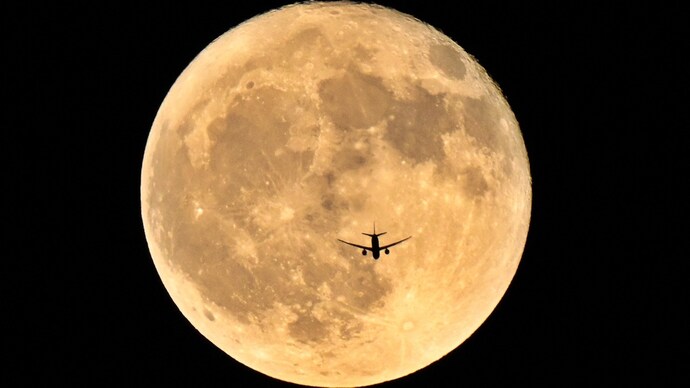The Moon lacks a global magnetic field today, making it unclear how these rocks became magnetized.

A commercial jet is silhouetted by the moon as it flies over Iraq's southern city of Basra. (Photo: AFP)
Lunar swirls, the enigmatic light-coloured, sinuous features on the Moon's surface, have long puzzled scientists.
Visible even from backyard telescopes, these swirls extend for hundreds of kilometers and resemble abstract brushstrokes. Recent research, however, has begun to unravel the mystery behind these fascinating formations.
Nasa images reveal that lunar swirls are not just artistic flourishes but are associated with magnetic anomalies. The rocks within these swirls are magnetized, deflecting solar wind particles that bombard the Moon. This deflection protects the swirls, keeping them light-coloured, while neighbouring rocks darken due to chemical reactions from solar wind exposure.
The origin of the magnetisation in these rocks has been a subject of debate.
The Moon lacks a global magnetic field today, making it unclear how these rocks became magnetised. Michael J. Krawczynski, an associate professor at Washington University in St. Louis, suggests that meteorite impacts could cause localised magnetic anomalies. However, he notes that some swirls' shapes and sizes cannot be easily explained by impacts alone.

Krawczynski proposes an alternative theory: underground lavas cooling in a magnetic field might create these anomalies. His experiments, detailed in the Journal of Geophysical Research: Planets, involved testing the effects of different atmospheric chemistries and magmatic cooling rates on ilmenite, a mineral abundant on the Moon.
The results showed that under lunar conditions, ilmenite could form magnetisable iron particles, especially in smaller grains with larger surface area-to-volume ratios.
This research suggests that subsurface magma, particularly high in titanium, could be responsible for the lunar swirls' magnetisation.
The findings align with hints of similar reactions in lunar meteorites and Apollo samples, though those were surface lava flows. Cooling underground would enhance these metal-forming reactions significantly.
Understanding lunar swirls is crucial for insights into the Moon's surface processes and its magnetic history. Future missions, like Nasa's planned 2025 Lunar Vertex mission to Reiner Gamma, aim to explore these magnetic anomalies further.
While drilling to confirm these theories is not yet possible, Krawczynski's experimental approach offers a promising method to test predictions about the unseen magma's role in creating the Moon's mysterious swirls.
Published By:
Sibu Kumar Tripathi
Published On:
Jul 5, 2024













 English (US) ·
English (US) ·